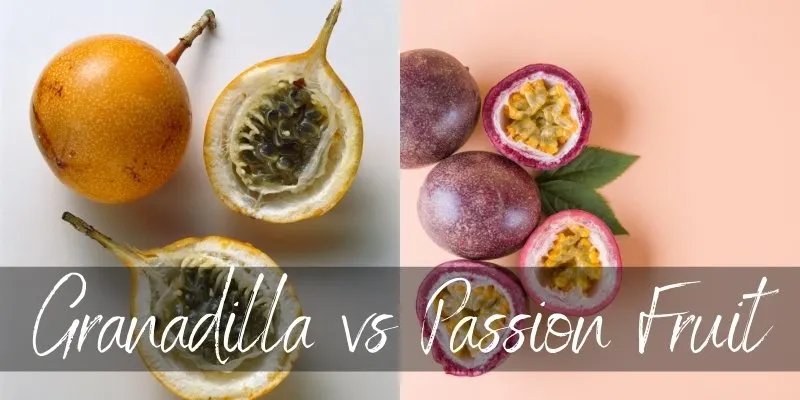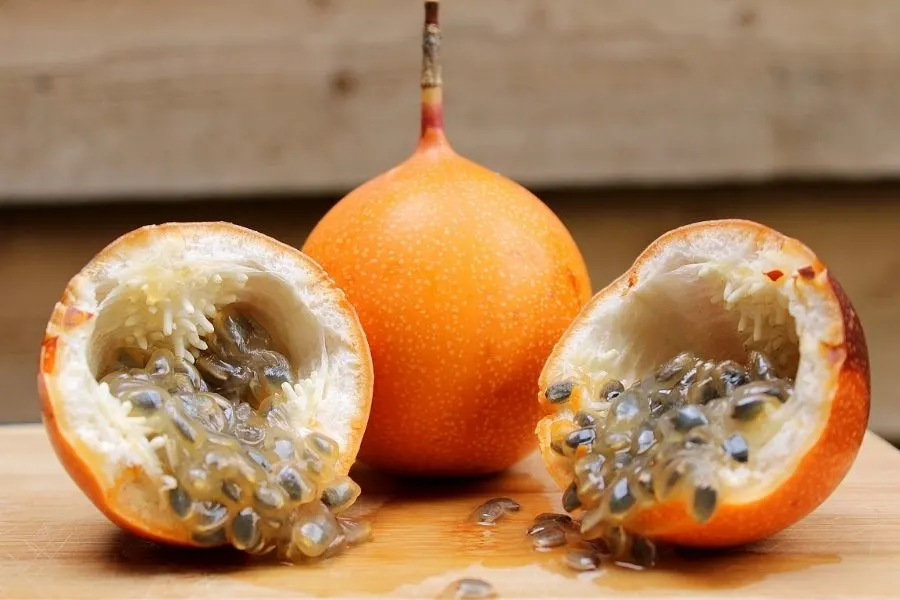If you’ve ever seen the beautiful granadilla flower, you might’ve mistaken it for that of a passion fruit! After all, both the granadilla and the passion fruit are from the same genus, the pentamerous (we’ll get to that later!) Passiflora.
For this reason they look very similar, but are actually different. How different ? Keep in reading to find out.

Granadilla VS passion fruit
Granadilla and passion fruit are closely related, but are different. Where the granadilla has a yellow-orange outer skin, the passion fruit is either bright yellow or deep purple.
Passion fruit is generally smaller than granadilla, and there is a big difference on the inside.
Both fruits have edible seeds, but passion fruit seeds are black with soft, yellow pulp while granadilla seeds are black but larger, with transparent, soft pulp.
To make matters more confusing, in some parts of the world, both beautiful, egg-shaped fruits are simply called passion fruits.
But, as we soon will learn, the granadilla and passion fruit are not exactly the same! And their differences may surprise you.
Overall, the passion fruit and the granadilla aren’t all that different; after all, they’re both from the same genus of vining, flowering plants! As such, both are native to South America and quite popular in tropical and subtropical climates today.
However, these two berries – yes, they are indeed berries – are different enough to be of two separate species. The granadilla, or Passiflora ligularis, gets its species name from its long, skinny daisy-like petals. Whereas the passion fruit, or Passiflora edulis, was simply named for its ability to be eaten.
Of course, both fruits are edible. But, as a species, Passiflora was named after something rather interesting: the Passion of Jesus Christ.
In the early 18th century, missionaries hailing from Brazil named it “the flower of the five wounds” because they saw its pentamerous – or its set of five plant parts, anthers in this case – as a symbol for Jesus’ five wounds.
Now let’s get to explaining these differences in detail, so you’ll tell them apart at a glance.
Granadillas and passion fruit look different
Despite the fruit’s flowers and vining stems, the granadilla and passion fruit themselves don’t look quite the same. On the outside, each is encased in a thick, colored skin, but each color is different! The granadilla is yellow, while the most notable variety of passion fruit is a deep purple.
However, their physical differences don’t stop there!
The granadilla, though filled with slimy seeds like the passion fruit, encases a pith and pulp that are a bit different in look than the passion fruit.
The gooey, mucus-like insides of the granadilla is clear, encasing within its muculence grey seeds. And the white pith (the area of the fruit that is right next to the rind) pulls away from the rind a bit.

The passion fruit’s design cannot say the same. Though the pith is also white, it tends to stick to the skin a great deal more than in the granadilla.
And the passion fruit’s insides are quite yellow in comparison, housing black seeds within its less syrupy pulp.
Read also: A Nifty Guide To Passion Fruit Season
Now, the granadilla is not to be confused with the yellow passion fruit or an unripe, green passion fruit.
Although both the yellow passion fruit and the granadilla are encased in a bright saffron colored shell, the yellow passion fruit contains the same sort of golden pulp inside as the regular passion fruit.
An unripe passion fruit is going to be green and quite hard in comparison.
But, that’s probably no help to you if you’re buying a closed fruit. So, if you want a granadilla and not a yellow passion fruit, keep your eye out for a less shiny shell with a bit more of an orange tinge than the yellow passion fruit’s pure yellow color.
Granadillas are much sweeter than passion fruit
The passion fruit’s flavor tends to be more on the sour, acidic side. As soon as you cut one open, you are sure to be taken aback by its strong, pungent scent. This, in turn, speaks to the passion fruit’s overwhelming flavor.
The passion fruit is not particularly sweet at all. In fact, you may need to add some sugar to it in order to enjoy its sour flavor. Many describe the passion fruit’s flavor as a mix between a sour, bitter grapefruit and a fragrant, floral strawberry.
Conversely, the granadilla doesn’t smell sour at all! Its scent is, in fact, quite faint, the only real discernable note being sweetness. And that explains a lot when you finally scoop its fruit into your mouth.
The granadilla is very sweet and not sour in the slightest like the passion fruit. No added sugar needed for this little guy. Many actually don’t know how to describe its flavor profile save potential notes of kiwi and melon. That being said, the granadilla is overall considered one of the tastiest, most calming fruits around.
It is also important to note that you can, of course, eat the seeds of each of these fruits. However, the rind of both the granadilla and passion fruit are not edible. You must scoop the fruit out of the shell in order to enjoy their vastly different flavors!
Read Also:Top 4 Reasons Why Passion Fruit Is So Expensive
They’re used a little differently
Now, whether you’re a top chef or a home cook, you may be interested in using one or both of these fruits in a meal!
Due to its pungent flavor and smell, the passion fruit is normally not eaten straight, but rather, as a part of a drink or sauce. It works great as a component of a salad dressing or other savory condiment, its sour taste working well with veggies and meats!

That being said, you will certainly see many sweets that feature passion fruit, as well. Today, you are sure to find passion fruit ice creams and jellies, all sweetened up, of course.
You may also use a passion fruit as a juice or cocktail component, mixed and watered down by other strong flavors.
On the other hand, granadilla is often seen only in sweet dishes due to its high sugar content. The granadilla could therefore be used in luscious cakes, creamy curds, and ever so sweet sippers!
But, no matter how you decide to enjoy these two fruits, you’re sure to enjoy their unique, exotic flavors!
Just remember, if you’d like to store either the passion fruit or granadilla, just place them in the fridge for up to two days.
If you need to keep them even longer, just remove the insides from the rind, place into a bowl or ice cube tray, and freeze for up to three months.

